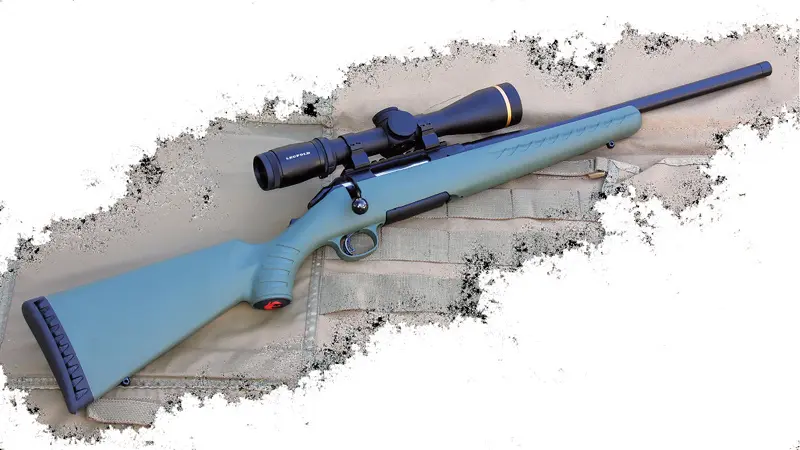

THE bolt-action rifle market is slowly shifting around us. Bolt rifles seem to be moving to two opposing ends: loss-leader cheapo guns and high-end, high-dollar beauties. Meanwhile the market remains hot for all things tactical.
Ruger, long known for providing performance at an attractive price point, has moved into the middle with its American rifles and recent .308 Win Predator model aimed at the tactical market.
Table of Contents
RUGER PREDATOR DETAILS
The 6.25-pound American Predator has a medium-weight 18-inch hammerforged barrel free floated in a synthetic moss-green stock. The 1:10 twist barrel ends in a set of 5/8×24 threads protected by a thread cap to allow the rifle to accept common suppressors or muzzle devices.
The pistol grip is fairly shallow and capped by a red Sturm, Ruger eagle logo that accents it nicely. The length of pull is a great fit for the tall and long of reach for position use and a good length for folks of average build from prone or a bench. I suspect it would be a tad long for the regular Joe in practical use.

The Marksman trigger has the now-familiar protruding safety and a comfortable, somewhat wide flat face. Whatever your favorite cliché about perfect triggers is probably applies here. Glass rod, icicle, candy cane— the trigger is noteworthy. This sample broke at just over three pounds with no overtravel and a great feel to it. I was recently behind some hand-built military sniper rifles and this trigger was five horse lengths better.
The Predator shares the short-action detachable box magazine of the parent American rifle. The magazine itself is a unique rotary set-up not dissimilar to the 10/22 and holds four rounds of .308. There is a generous relief in the stock where the magazine release latch is located, which allows the shooter to easily get to the latch and “flick” the empty mag out.
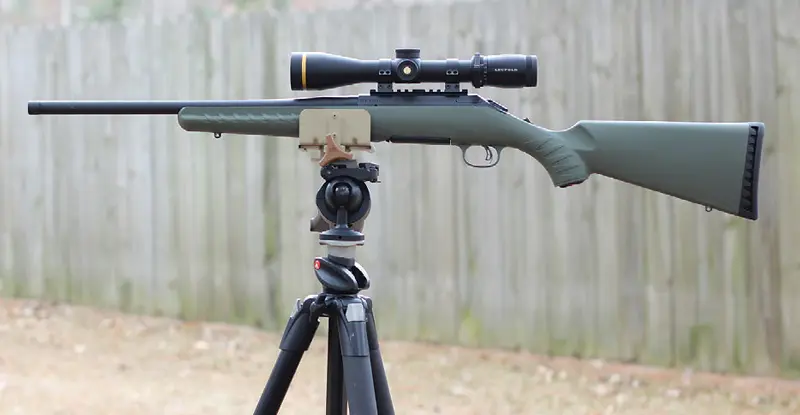

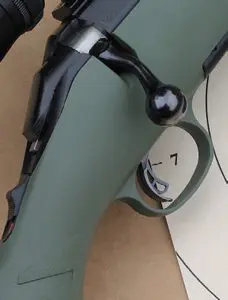
The mag seats easily and flush with the stock, so the shooter can reload the rifle quickly by starting the mag into the stock and wiping the hand forward down the length of the magazine, clicking it in as the support hand slides down the stock into position.
The safety on the American series is a tang-mounted slider, rearward to safe and forward to fire. It is a fast, ambidextrous arrangement that is preferable to much of the competition.
Another feature of the American series that the Predator benefits from is the bolt. The bolt has a 70-degree throw that easily clears most any scope with room to spare. Cocking is on the upstroke and is further split into two points of travel to reduce the force required. This results in a slightly unfamiliar feel at first, but definitely eases the unlocking of the action.
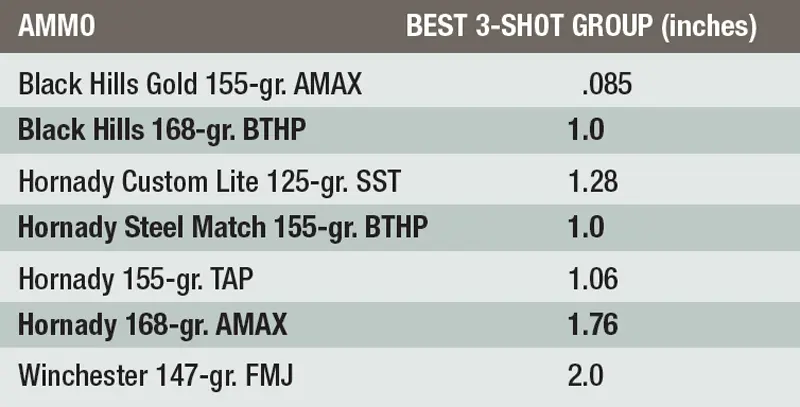

The bolt travels along the short action very smoothly and locks with three lugs that are contoured in such a way that chambering and locking are very smooth. The action is pretty smooth by design and slicked up quickly in dry fire and use to a nice degree. The rear of the bolt has a cocking indicator that protrudes to show the rifle’s status.
The Predator differs from the standard American in having a Picatinny type rail mounted in place of the scope bases. I say type, because there are portions of the rail that have wider crosssections to accommodate the necessary mounting screws, so QD mounts that are fine on a flat-top AR may not mount onto the Predator without adjustment.
I tried a couple of optics from my ARs and they were usable but too high to work well. A shooter who likes a high mount could possibly add a laceon cheek piece to the Ruger stock and swap optics between his ARs and the Predator, but I settled on medium rings.
The finish is a utility-oriented flat black. The overall finish and appearance strike me as a bolt gun for the Glock crowd. The cost savings in the American line are partly attributable to the lack of metal polish, with the flat, weather-resistant finish practical and analogous to what one would normally find on an AR or a polymer service pistol.
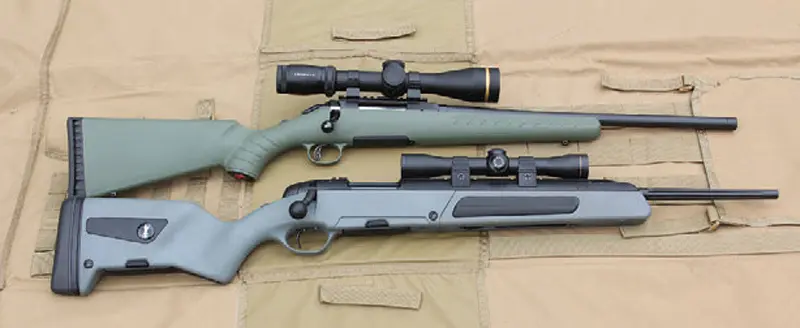
But as much as the flat finish and visible mold lines on the stock might offend a pre ‘64 Winchester fan, I find the overall lines of the Predator attractive in the modern sense. It also has the “pretty is as it performs” factor, with the Predator having form that speaks to function.
This is in contrast to many of the loss-leader models, which seem engineered solely to be cheap to pump out and crudely resemble a useful tool for a rifleman.
BULLET HOLES
I was tempted to go with a lightweight low-power optic on the Ruger to take advantage of the rifle’s trim weigh-in, but decided I wanted a little more versatility and range. I mounted a Leupold VX-6 2-12X optic on the Predator and was pleasantly surprised that the balance remained lively in the hands, with just enough weight out front to steady the rig on offhand shots.
The overall system weight and balance are an effective compromise: good in snap shots from positions as well as from supported on rests and barricades. The sporter profile of the stock isn’t necessarily ideal for nestling into a support or sandbag, but it didn’t prevent good shooting either.
On the other hand, many shooters who select heavy varmint or sniper- style stocks wind up fighting their equipment in any position other than a textbook prone or seated bench.
Mounted in a Shadow Tech PIG Saddle on a tripod, the Ruger shot well outside its price bracket at 100 yards. Best group honors went to the Black Hills Gold 155-grainers, which launched three shots into a .85-inch cluster. Hornady Steel Match 155-grain boat-tailed hollow points cut an even inch, as did Black Hills classic 168-grain Match load. Hornady law enforcement TAP 155s were close behind at 1.06 inches.
Accuracy was quite good and consistent with these loads, with all groups shot with the top four selections averaging 1.13 inches. I have a feeling that as the barrel breaks in, the rifle will settle in even a little better on best groups and averages.
Recoil was there, but the stock is well laid out and capped with an absorbent pad, so it was in no way unpleasant. I tried the new Hornady Custom Lite 125-grain SST loading, which is meant to cut recoil by up to 40%. Pushing a rapidly expanding bullet at 2,675 feet-per-second, the Custom Lite was a great match to the relatively lightweight Ruger, cutting recoil and recovery significantly.
DRILLS
I am always interested in how fast a rifle will go in the “right there” bracket. I set up a target at seven yards and put the Predator on the timer. Average time to cycle the bolt and fire an additional round was 1.17 seconds. The action is slick and easily worked from the shoulder with no bobbles.
The attractive teardrop-shaped bolt handle was smallish for me, slightly slowing the otherwise fast action as I tried to get a good purchase at max speed. Whether anyone offers “tactical” bolt handle replacements for the Ruger American rifles will undoubtedly depend on how deeply they penetrate the market.
In shooting the rifle through a variety of drills, I found it easy to hit with. Whether four-inch Red Stitch Tactical steel targets from a barricade at 100 yards or attempting to make the times on 25-yard pairs from carbine quals, the Predator delivered.
The one scab to pick was that single loading the bolt gun was a non-starter. Attempts to drop a round into the open action and close the bolt were generally unsuccessful no matter how the rounds were oriented. The rounds need to be placed all the way in the chamber, which is tricky from the action without the aid of gravity. Luckily, the magazine is exceptionally easy to reload by bolt gun standards, so single loading is probably a poor alternative anyway.
MULTI ROLE
In Vietnam, the Predator would have undoubtedly been best described as a sniper rifle, and it would have surpassed most of what was available then with some or all of its features. A magazine- fed free-floated weather-resistant sub-MOA .308 rifle that directly mounts a suppressor? Yes, please!
Today, shooters tend toward hyperspecialization, which leaves the Predator in the middle ground between light hunting rifle and light precision rifle. That naturally begs the question: “What is it for?”
After a few months with it, I think it is a great entry in the emerging practical/ tactical bolt gun genre that can do any .308-appropriate task reasonably well. I suspect most Preds will be snapped up by veteran AR shooters who want to try a bolt gun for some precision shooting and/or hunting but have no interest in the traditional blue steel and walnut route.
I actually find the Predator to have more in common with the Scout Rifle concept than today’s vision of a precision rifle. The comparison photo on page 61 gives an idea of how close the Ruger is in size to a Jeff Cooper Model Steyr Scout. To me, the Predator seems like the love child of a Scout and an M40A1. It is light enough to be no burden to carry and heavy enough to get relatively stable in position. Importantly, it also has enough precision to take advantage of current advances in rangefinders, ballistic calculators, and optics to reach out toward the other end of the .308 curve.






1 comment
I’ve read articles and seen videos from guys being on and hitting targets at 1000 yards with this rifLe. Pretty certain it would faire well as deer rifle anywhere in the united states. I’m shorter than the average joe, but still find this reifle comfortable to shoot in all positions until putting on a hEavy coat / Jacket and winter gloves. The American compact fits better then.